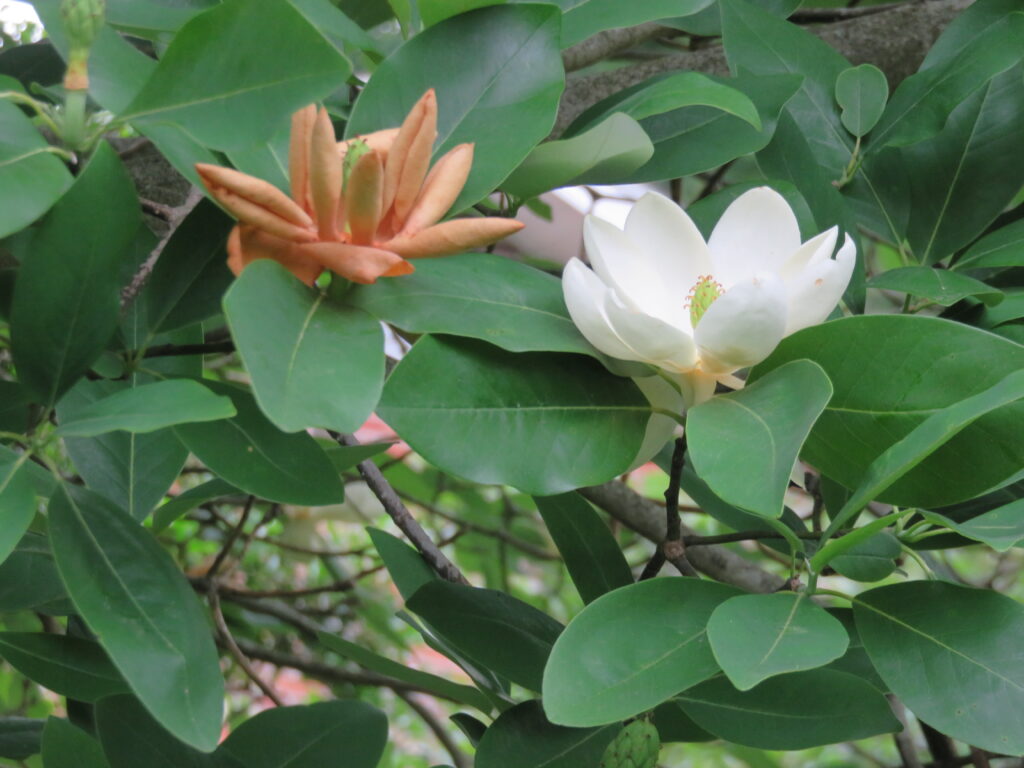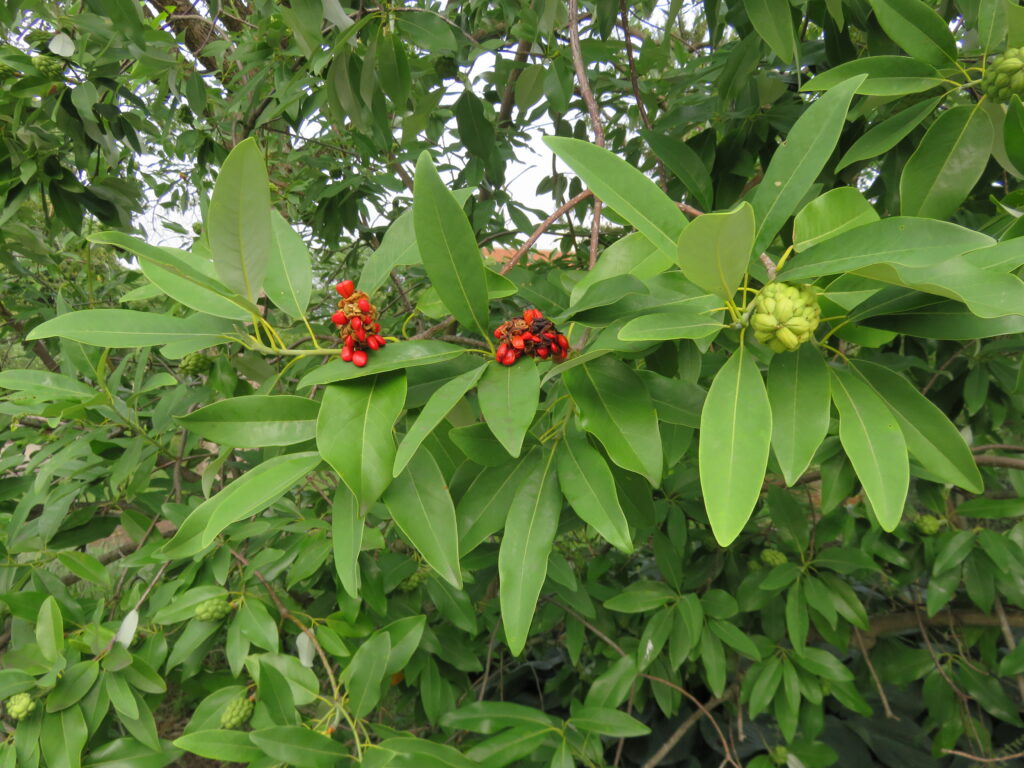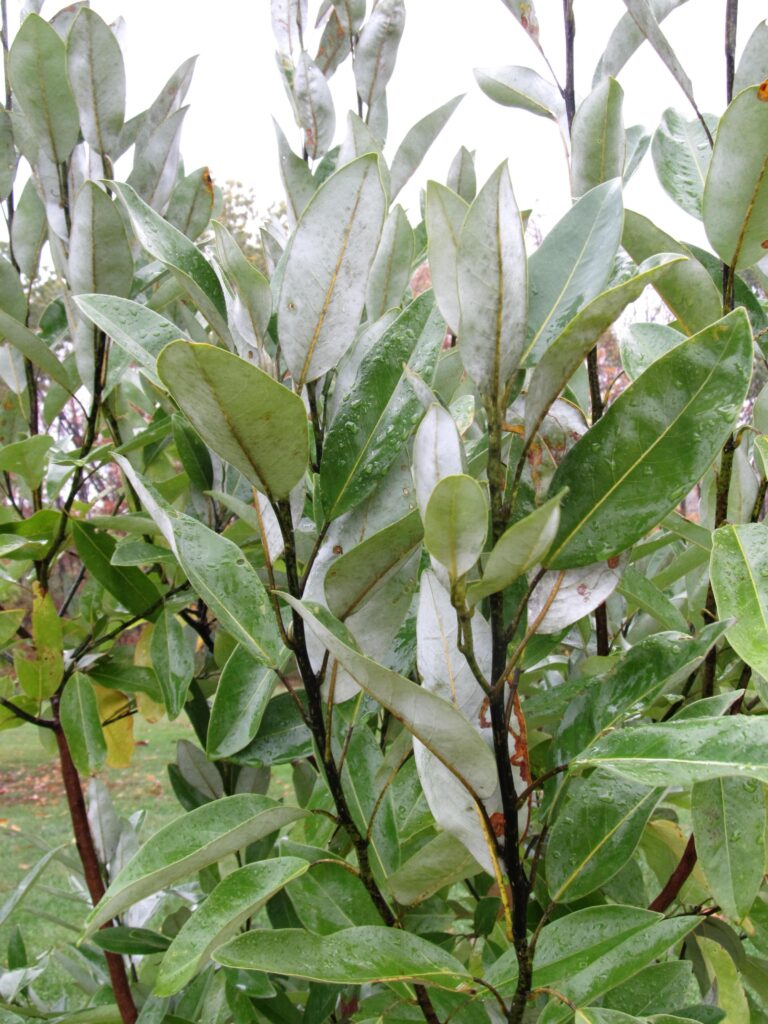Sweetbay magnolia (Magnolia virginiana) is a U.S. native tree that is finally catching on with landscape designers. Sweetbay often grows 20-30 feet tall and 15-20 feet wide as a large shrub or multi-stemmed small tree. Discovering a 50-60 feet sweetbay near by a lake or pond is not unusual to find (USDA hardiness zones 5-9).

Sweetbay blooms from mid-May through June with occasional flowers from May into July. The flower petals of magnolias are called “tepals” and sweet bay flowers consist of 8-10 tepals. The creamy-white blooms are 3-4 inches across and last 3-4 days. Numbers of open flowers are rarely abundant at any one time. On occasion their sweet lemony fragrance becomes quite evident in the late spring garden.
The glossy light-green leathery leaves are 4-5 inches long. A slight fluttering breeze exposes the silvery underside of the leaves. Foliage is reliably evergreen in USDA hardiness 7-9 and semi-evergreen in zone 6. ‘Green Shadow’ and ‘Moonglow’ are leading cultivars that exhibit slightly larger flowers, darker green leaves, and better winter hardiness.
In early fall green cone-like seed capsules burst open to expose bright orange to red seeds within. Seeds may be collected in late September and stratified (refrigerated) in moist sand over 3 months @ 32 to 41°F; or seeds may be sown directly in the garden. Seedlings emerge from the soil the following June.
Unlike most magnolia species, sweet bay flourishes in moist soils, including those that are flooded for short periods. This species tolerates wet, swampy, and boggy soils whereas most other magnolias abhor “wetfeet”. ‘Australis’ forma are more reliably evergreen than the species. It prefers a humus-rich, acidic soil; summer leaves may turn chlorotic (yellow) in iron deficient alkaline soils. Disease and pest problems are rare.

Sweetbay is well-suited for a small urban garden near a patio or deck. Cut foliage is often included in holiday wreaths and garlands, and in table and floral arrangements.
Choose from dozens of sweetbay magnolia cultivars, including these 8 popular forms. Some cultivars are listed under two names. Verify winter hardiness ratings before purchasing; some will defoliate following a harsh winter. Some are winter hardy to zone 7, while a few are winter hardy in zone 5 and retain their foliage through winter:
- ‘Emerald Tower’ grows to about 20 feet, with glossy green foliage along with exceptional zone 4 hardiness.
- ‘Green Shadow’ (M. virginiana. var. australis), also named ‘Greenbay’, was introduced by Tennessee Nurseryman Don Shadow from seedlings collected by Dr. Joe McDaniel.
- ‘Moonglow’ (‘Jim Wilson’) grows 15-35 feet tall and 10-20 feet wide.
- ‘Henry Hicks’ is an unusually large 35-40 feet tall cultivar exhibiting a more columnar growth habit and is rated evergreen in zone 5.
- ‘Keltyk’ has smaller leaves, a more compact habit, and is evergreen in zones 7-10; utilize as a 25 feet patio tree; creamy white flowers are highly fragrant on a summer evening.
- ‘Santa Rosa’ has the largest leaves of any cultivar and has a spreading habit that grows to 25 feet tall and 20 feet wide; best in zones 6 – 9.
- ‘Northern Belle’ grows 20-25 feet height and 15 feet width; large white blossoms that emit a vanilla fragrance from May to July.
- M. (australis) ‘Mardigras’ (‘Mattie May Smith’) has unique variegated foliage (yellow margin/green center leaves); 15 feet shrub or tree; semi-evergreen foliage; Zones 5 -7 winter hardy.


 Posted in
Posted in 
